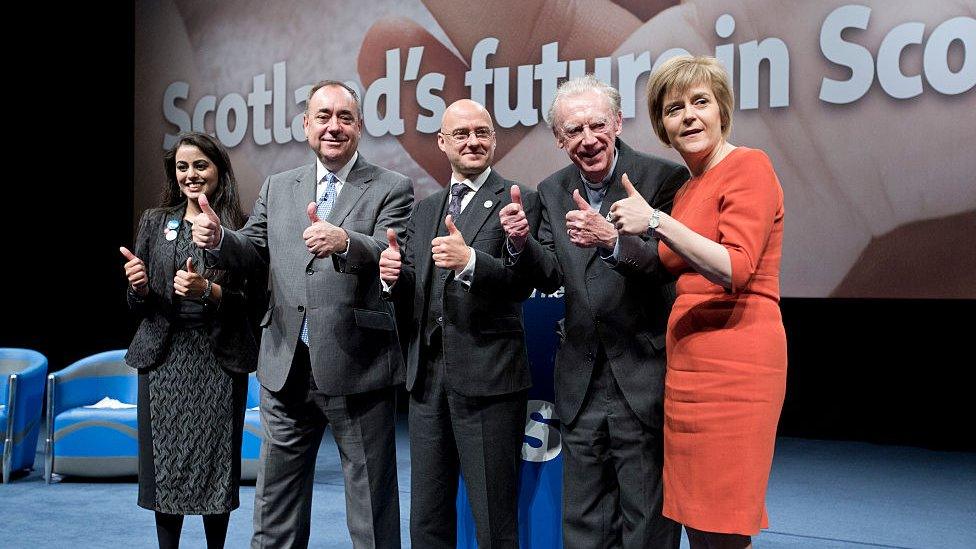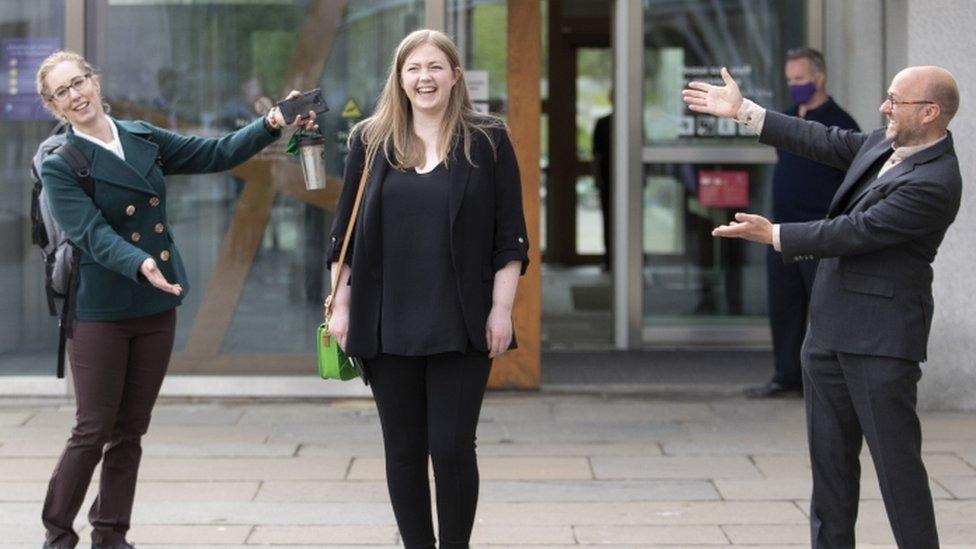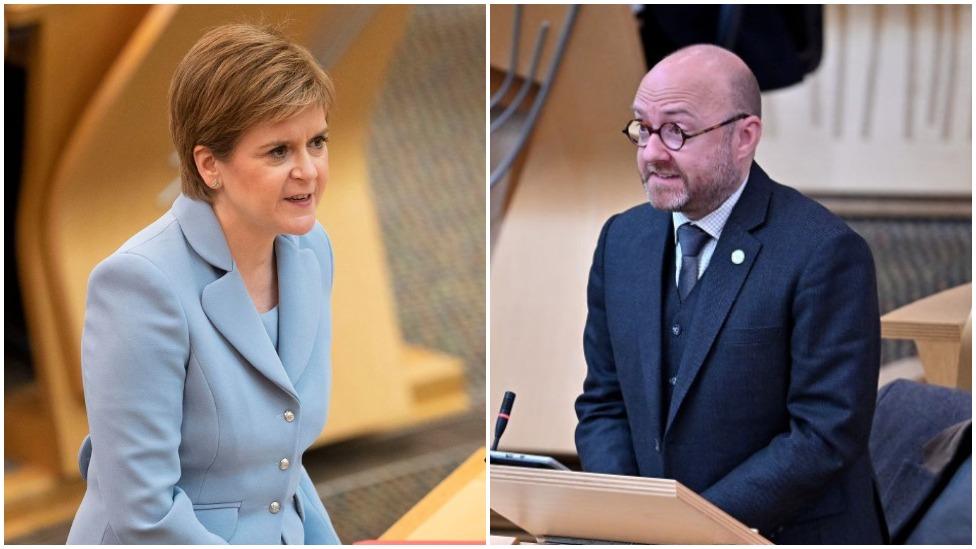Why do the SNP and Greens want to do a deal?
- Published

The SNP has opened talks with the Scottish Greens about entering into a formal cooperation agreement at Holyrood. What could this deal look like, what's in it for each party, and what could it mean for the Scottish government?

What's going on?
There is always lofty talk of collaboration and cross-party working in the wake of an election, particularly from the victors.
But in 2021 this appears to have gone a step further, with the Greens and SNP entering formal talks over a "cooperation agreement".
There has already been a Bute House summit between party leaders, and the civil service will now support discussions about what a deal would actually look like.
These talks are likely to continue for weeks to come, but have already been talked up by First Minister Nicola Sturgeon as "potentially ground-breaking" and a new way of doing politics in Scotland.
How might it work?
What exactly any eventual deal looks like will depend on the talks to come, but there have been a few hints.
The plan seems to be for something greater than a basic confidence-and-supply arrangement, where the Greens agree to back the government in budget and confidence votes - but possibly short of a formal coalition, like the Labour-Lib Dem pacts of old.
Ms Sturgeon said she could not rule out Green MSPs taking up posts in her government, which might have some her newly-appointed ministers looking nervously over their shoulders.
The Greens themselves suggest this could follow a model like that in New Zealand - reference to the government of Jacinda Ardern apparently being mandatory in any political debate of late - where a cooperation agreement is in place despite Labour having an outright majority.
This put both Green co-leaders into junior ministerial offices, with Ms Ardern saying the point of the deal was to "reach as wide a consensus on key issues as possible".
Something similar may be the intention in Scotland, with the parties zeroing in on "specific policy areas on which to cooperate" - with climate change presumably at the top of the list in the year of the Cop-26 summit.

In New Zealand, Green co-leader Marama Davidson (left) joined the government of Jacinda Ardern (right)
What's in it for the SNP?
Ms Sturgeon insists the SNP already have a stonking mandate from the Scottish people - and indeed they are in a stronger position now than they were before the recent election, with parliament effectively tied 64-64 after Green MSP Alison Johnstone became Presiding Officer.
The first minister insists the move is not about parliamentary arithmetic, noting that "neither of us are doing this because we need to".
However she also said there would be talks about "reciprocal support" the government could receive from the Greens, which likely boils down to votes in parliament.
There were points in the last term where SNP plans ran aground after failing to win opposition support - like the Education Bill which went from a flagship policy to being shelved, or the attempts to resurrect the Named Person scheme.
To be clear the parties would likely still be free to disagree on a whole range of subjects, and the government would not be immune to defeat - but Ms Sturgeon might feel that bit more comfortable with greater numbers on her side in parliament.
And then there's the issue of independence, which is never far from the surface in Scottish politics. The Greens were already going to back any referendum legislation, but it might be felt that a formal agreement between the two could represent a more convincing mandate than the arrangement of last term - which after all failed to actually deliver a referendum.

The Greens and SNP teamed up as part of the Yes Scotland campaign in 2014 and remain aligned on constitutional issues
What's in it for the Greens?
The Greens were arguably the biggest winners of an election where not much changed, gaining two seats and cementing their position in fourth place at Holyrood.
With the SNP falling short of an outright majority, they were also in pole position to do budget deals - and thus turn some of their policy proposals into reality.
They were talking about pushing the government to go further and faster on things like climate change even before the possibility of a cooperation agreement became public knowledge.
The party's leaders apparently feel they could have even more influence by striking a deal with the SNP now, rather than working on an issue-by-issue basis or indeed year-by-year.
This might mean getting Lorna Slater or Patrick Harvie an office in St Andrews House, or it might mean some Green manifesto pledges being added to the next programme for government.
The other calculation may be that the Greens are unlikely to suffer the common fate of junior coalition partners in future elections.
Their electoral strategy is broadly to sweep up list votes from people who vote SNP in constituency contests, so they might actually be rewarded for this kind of move - rather than being punished to the extent of Nick Clegg's Lib Dems, who suffered at the polls after entering a coalition at Westminster with the Conservatives.
And of course if the pro-independence parties get their way, they may not be banking on there being another Holyrood election under the current constitutional settlement.

A raft of new Green MSPs are arriving at Holyrood this term
What about other parties?
Ms Sturgeon was keen to stress in her Holyrood statement that she wants to "reach out to find the best solutions to the toughest problems", and to return to the cooperative spirit envisioned by the architects of the Scottish Parliament in 1999.
She revealed that she had already had talks with Anas Sarwar about potential areas of agreement with his Scottish Labour party.
But while there may be policies the parties do agree on, a broader deal with Mr Sarwar is unlikely, given his goal of building Labour into a credible alternative to the SNP.
And his response to the announcement at Holyrood was to have a dig at "the Greens accepting and formalising their coalition of cuts with the SNP".
The Lib Dems meanwhile have been reduced to four MSPs, meaning they are no longer guaranteed things like leaders questions at FMQs - and thus struggle for influence. They will likely continue to try to eke out budget deals around their favourite policy areas but may be frustrated by the Greens yet again.
The Conservatives meanwhile will likely eschew any hint of cooperation, having pitched themselves at the election as a strong opposition to the SNP, not a potential partner.
This will be particularly the case as Ms Sturgeon starts to build up her plans for a referendum - and that goes for all three unionist parties. A deal with the Greens is easy, because it doesn't need to overcome the biggest hurdle in the debate.
The constitution remains a gaping faultline across the middle ground of Scottish politics, and it will take a lot more than talk of a new way of doing things to bridge that.
- Published26 May 2021
